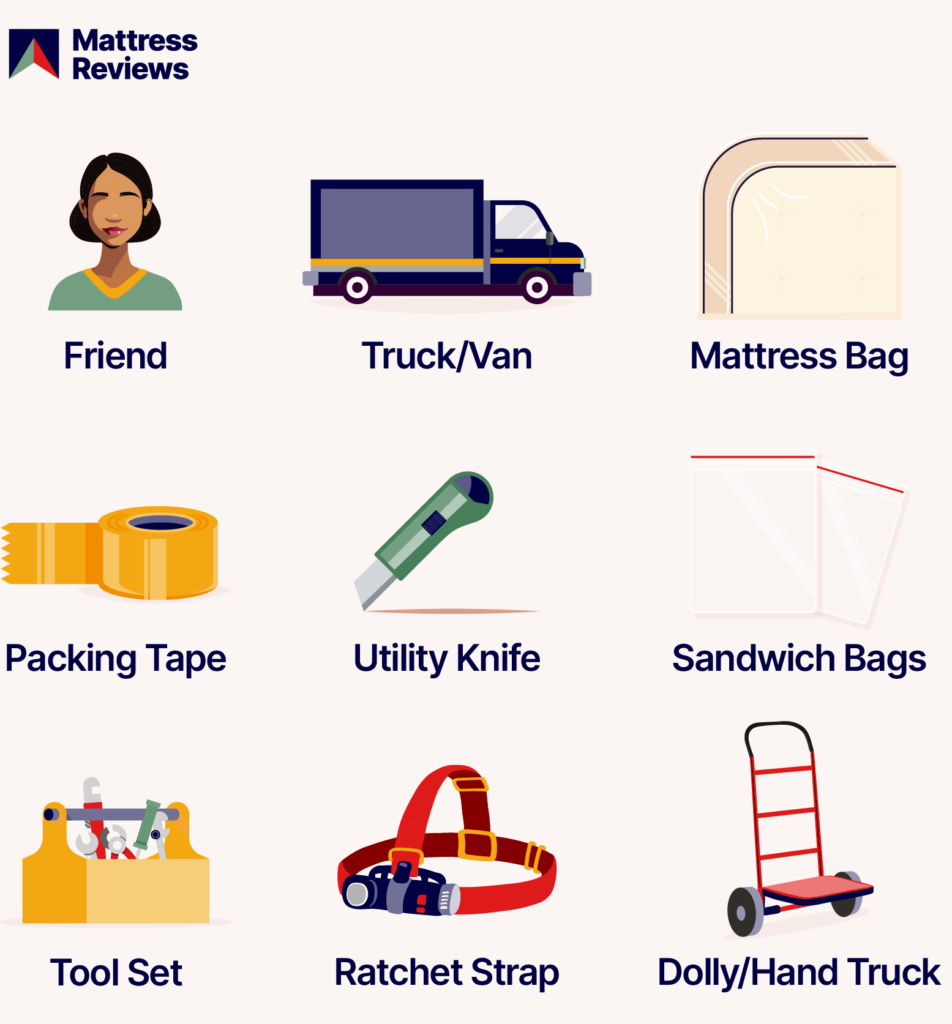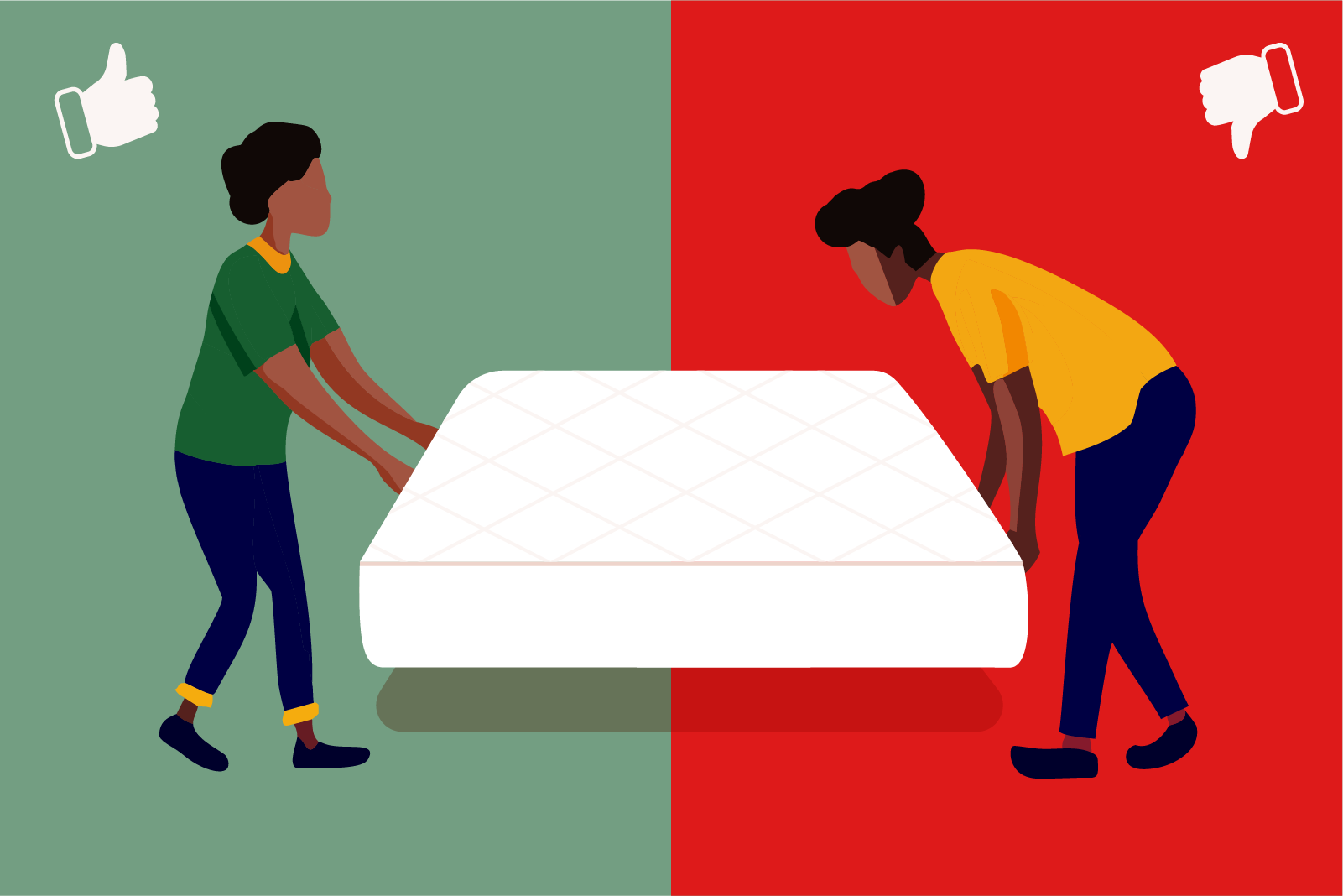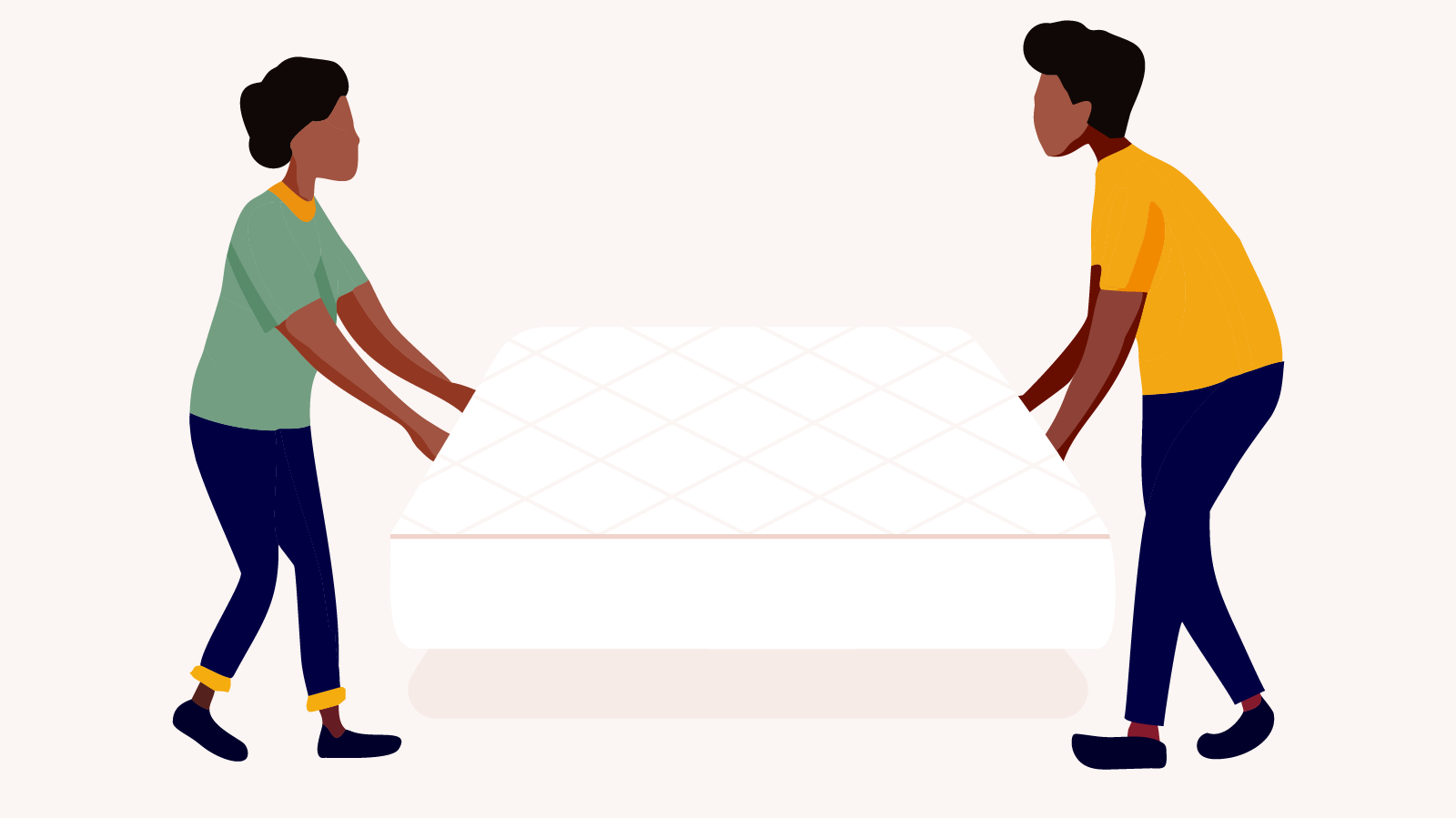How to Move a Mattress: 9 Simple Steps (2025)
Updated: March 3, 2025 | Published: July 2, 2024Most of us, at some point in our lives, will have to move a mattress. Whether you’re moving to a new home or just buying a new mattress, it’s important to move the mattress properly to avoid frustration or injury.
We’ve gathered all the information you need to learn how to move a mattress, hassle free. Get practical tips, FAQs, and reminders, along with a handy downloadable checklist.
1. Use our checklist for moving a mattress
Start with our handy checklist of practical things you’ll need before moving a mattress.

- A friend to help you move. Mattresses can be heavy. The average queen-size mattress weighs 120–160 lb, depending on whether your mattress is foam, hybrid, or innerspring. Ask a friend to help you move the mattress to avoid damaging it or injuring yourself.
- A truck, large van, or moving van. While a pickup truck or family van can transport a smaller mattress over short distances, it isn’t ideal for a longer trip and won’t fit larger mattresses. Get a bigger vehicle to make moving easier on yourself. Plus, you can anchor the mattress and base to the side of the truck so it doesn’t move in transit.
- Mattress bag. A lot of mattresses don’t have machine-washable covers. A bag helps protect your mattress and keep it clean during your move. You can find mattress bags online or at most storage outlets and hardware stores.
- Packing tape. Packing tape can help keep mattress bags closed, repair tears in plastic or other materials, wrap cords, keep drawers shut, and attach your bag of bed hardware to the foundation so it doesn’t get lost or misplaced.
- Utility knife. A utility knife is great for cutting and trimming, especially packing tape, rope, and tie-down materials, as well as for carefully opening taped boxes. Get a knife with a retractable blade to help prevent possible injuries.
- Sandwich bags. These bags are useful for holding screws, nuts, bolts, and other small objects you want to find later. Double-bag any heavy bags, then wrap the closed bag around a bed rail with packing tape. Bags also cover the ends of furniture legs, smaller wheels, and other bases you want to protect during transport.
- Tool set. A basic set will do, along with a utility screwdriver that has the most popular kinds of screw heads already included. That way you don’t have to go digging for the one you need. You may also want to include a small hammer, scissors, and a measuring tape.
- Ratchet strap. These straps are made of durable webbing and are useful for securing the mattress in the vehicle. You can also use a cam buckle strap, which is more lightweight. Or, if you don’t have a strap handy, you can also consider using elastics, bungee cords, or zip ties.
- Dolly/hand truck. Transport your mattress more easily over longer distances with a dolly or hand truck. If you’re renting a moving truck, they often have different sizes of dolly or hand truck rentals available. Just make sure yours can handle the weight of a mattress.
2. Prepare your mattress for moving
To avoid damage to your mattress, make sure it’s protected during transportation and setup in your new place. Follow these steps to get your mattress ready for moving:
- Strip the bed. Remove all linens except the mattress protector, if you already have one on the mattress. (If there are any marks, rips, or stains that need to be addressed before you wrap up the mattress, this is a good time to fix them.)
- Check the law label. Before you move the mattress, it’s a good idea to check the law label to see whether the mattress contains fibreglass. This low-cost fire retardant can present a health risk if your mattress is damaged or the cover is opened in transit.
- Place the mattress in a bag. You can also wrap the mattress in a sheet of heavy-duty plastic. Then, seal the mattress bag with packing tape and mark which room it belongs in at your new home.
- Fold all bedding. Place the bedding in a clear bag or bin for transporting so you can see what’s inside. It’s also a good idea to mark the container with the room where it should go at the new location.
- Measure the bed. Note your mattress size and dimensions, and do the same for your box spring and frame. This will help you choose the right size of vehicle for transporting your bed to its new home.
- Disassemble the bed frame. If you have a type of bed frame that can be disassembled, take it apart for easier transportation. Put all the hardware in a sandwich bag, tape it closed, and securely tape the bag to the bed frame so you can find it later.
If you live in an apartment building, this is a good time to speak with your building manager about booking the elevator. This can be helpful for moving your mattress down to ground level.
3. Make a path from the bedroom to the vehicle
Once you’ve prepared the mattress and disassembled any furniture, it’s time to clear a path to the moving vehicle. That way you don’t have to put the mattress down at any point.
Here are some tricky scenarios and possible hazards to consider before you begin moving a mattress:
- Can you see around the mattress while you’re moving it?
- Do you have to move the mattress down the stairs?
- Will you have to pivot the mattress around a tight corner?
- Are there low-hanging light fixtures or cords to watch out for?
- Are there any tight doorways where you might pinch your fingers or scrape a knuckle?
- Do you have to get the mattress through a screen door?
- Are there any slipping or tripping hazards to keep in mind?
- How’s the weather? Do you need to protect floors from water or mud on your shoes?
If possible, get a third person to act as a spotter. They can watch as you’re moving the mattress to tell you how much room you have to work with, or hold doors open so you can get through.
4. Lift the mattress and start to move
It’s time to begin moving the mattress. Follow these instructions to work safely, avoid injury, and prevent damage to the mattress:
- Slide the plastic-covered mattress off the bed and onto the floor.
- Lift the mattress with your partner so it rests on its long side.
- Place the dolly or hand truck under the centre of the mattress.
- Lay the mattress flat on its side on the long end, with one person at either end of the mattress to move it.
- Count to three, and have both people lift the mattress together to place it on the dolly.
- Bend at the knees to lift the mattress, and only lift as much as you need to.

From there, you can move the mattress through the house on the dolly. Take care to avoid running into corners, wall hangings, or furniture.
If you need to move the mattress down a set of stairs, follow these instructions:
- Slide the mattress along the floor toward the stairs.
- Depending on how much height you have and whether you’re clearing any light fixtures, you should be able to move the mattress on its short end down the stairs.
- Guide the mattress slowly down the stairs while keeping it under your control. Be mindful of the weight of the mattress, any slipping or gripping issues, gravity, and momentum.
- If the stairs have a tight corner, pivot the mattress on the corner edge to clear the wall and railing before bringing it down the last section.
5. Load the mattress into the moving vehicle
If your moving vehicle has a ramp, it should be easy to move the dolly and the mattress onto the truck. One person can guide the mattress while the other pulls the dolly up the ramp.
If you don’t have a ramp, have one person tilt the dolly back to make the mattress easier to grip. Then lift the mattress together, bending at the knees and keeping the mattress close to your body, to guide it into the truck on its side.
6. Secure the mattress in the vehicle
Here’s how to secure the mattress for transit, depending on the type of vehicle you’re using:
Moving Truck
If your mattress isn’t too heavy and you have other furniture, you can place it on top of the other furniture, ensuring you keep it straight, level, and supported during transport.
However, if the only way you can transport the mattress is on its side, use the long side and try not to leave it stored that way for more than a couple of hours. Use the racks on the side of the truck to tie down the mattress with ratchet straps.
Make sure to keep your truck evenly balanced on both sides, in the front and in the back.
Van/Full-Size Vehicle
You may need to angle the mattress to one side to make it fit. However, try to ensure the mattress is properly supported at all times, without bending. Use straps to tie down the mattress if needed.
Make sure you can close the tailgate or back hatch. If not, secure the door with rope so it stays as closed as possible. Ensure there are no objects that could fall out of the van during transport.
If the mattress extends past the end of your vehicle, follow any road restrictions for oversize objects—for example, taping an orange flag to the mattress for visibility.
Car/Smaller Vehicle
Ideally, you’ll have a roof rack to use to strap down the mattress. If not, you’ll have to strap the mattress down to the car itself.
Note that this isn’t an ideal way to move your mattress. It’s more exposed to the elements, it’s harder on your vehicle if it’s windy, and you need to make sure it’s properly secured. That said, sometimes it’s the only option available.
Make sure your vision isn’t obstructed while you’re driving, and your licence plate is visible at all times. If you have an innerspring mattress, stabilize it as much as possible to avoid bending.

7. Drive the mattress to its new home
Once the mattress is secure, it’s time to drive it to your new location. Here’s how to transport a mattress safely in your vehicle:
- Map out the easiest route that doesn’t involve highway speeds, if possible.
- Drive smoothly and avoid sudden starts or stops. This helps your load to stay stable. If a light ahead is changing, let off the gas pedal and coast as much as possible, coming to a gentle stop.
- Allow plenty of time and signal if you need to change lanes, but try to stay in the right lane as long as possible.
- Ensure your mirrors are free of any objects, and shoulder check often to be aware of vehicles around you. If you’re driving a moving truck, remember that you won’t be able to see any vehicles behind you that are closer than about 10 feet.
- Drive with a friend who can keep an eye on the mattress, allowing you to keep your eyes on the road.
8. Unload the mattress
You made it! Now it’s time to unload the mattress at its final destination. Follow these steps to get your mattress out of the vehicle and into your new home:
- If needed, get your friend to help you back into your designated parking spot.
- Be careful when opening up the vehicle, as contents may have shifted during transport.
- If you have a moving truck with a ramp, slide the mattress onto the dolly on its side. Then guide the mattress down the ramp and onto ground level.
- If you don’t have a ramp, slide the mattress off the truck and gently lower it to the ground. Then slide the mattress onto the dolly on its side.
- You may need to remove the mattress from the dolly long enough to get it up the front steps and through the door.
- Use the dolly to transport your mattress to its new room.

9. Reassemble your bed
If you had to take apart your bed frame to move it, now’s the time to put it back together.
Move the bed frame pieces to the room where you want to place the bed. Then get your toolbox and reassemble the headboard, footboard, rails, and other pieces of the frame.
Finally, unwrap your mattress and place it on the bed frame. If you didn’t clean the mattress before you moved it, now’s a great time to freshen up the mattress before making your bed.
FAQ
Should I move my mattress or just buy a new one?
The average lifespan of a mattress is 8–10 years. If your mattress is already at that point, think about replacing it and having the new mattress delivered to your new location. You also might want to consider a new mattress if your new room will be significantly larger or smaller.
However, if your mattress is still in great shape and will fit the new space, there’s no need to replace it just yet.
How do I move a mattress alone?
Need to move a mattress by yourself? The average queen-size mattress will be too big and heavy for one person to lift, but a twin or twin XL is doable. Here’s how to move a mattress alone:
- Use mattress straps to create your own handles, or lift the mattress onto a dolly one corner at a time.
- To move the mattress down the stairs, let it slide down while you guide it. You can steer the bottom of the mattress around any corners and let it slide to the bottom on its own.
- Once at the bottom of the stairs, slide a mattress on its side toward the door using the dolly or mattress straps.
- Lift the end of the mattress slightly to get it over the threshold of the door.
- Since the mattress is encased in plastic wrap, you can slide it onto a couple of pieces of cardboard, then slide the mattress along the sidewalk until you get to your vehicle.
- Turn the mattress onto its short end, then tilt and push it into your vehicle. Bend your knees and engage your core muscles to avoid injury, and keep the mattress close to your body.
- Reverse this process once you’ve transported the mattress to your new home.
READ MORE: How to put on a duvet cover by yourself
Can I fold or bend my mattress?
We don’t recommend folding or bending any type of mattress, as this can cause damage and potentially void your warranty. If you have a memory foam mattress, it should be transported and stored flat to prevent cracking or other damage.
Not sure of the safest way to move your mattress? Talk to your mattress manufacturer’s customer service and get their advice.
Will my warranty protect my mattress during moving?
Warranties normally only cover manufacturing defects, not damage caused by moving.
To avoid this damage, transport your mattress in a bag and avoid tearing the mattress’s fabric handles (if it has any). Make sure the mattress is properly supported in the vehicle during transport, too.
How do I store a mattress if I’m not using it right away?
Before storing your mattress, make sure it’s clean and dry. Then put on a mattress protector, place it in a mattress bag, and seal the bag with packing tape along all open sides. Repair any holes with packing tape before storing the mattress.
Store the mattress flat, ideally with nothing else on top of it. Avoid storing the mattress on its side, as this can damage the mattress’s internal layers.
With the help of friends and these handy tips, you should be able to successfully move your next mattress without frustration or injury. Wishing you a successful move!
Our goal is to provide the information you need to find the mattress that’s right for you. Get started with some of our most popular mattress shopping resources:
- Best Mattress Guides: Best Mattress Canada, Best Mattress In a Box
- Reviews: Douglas Original, Logan & Cove Choice, Juno, Octave Vista
- Comparisons: Douglas vs Endy, Douglas vs Casper
We use independent, third-party engineering firms (commissioned by us) with the APEGA stamp of approval to conduct mattress testing on our behalf, using publicly available data. We review and test all mattresses on 40+ criteria we think are important to you, including price, country of manufacture, sleep trial, warranty, features, materials used, motion isolation and edge support ratings, customer satisfaction reviews, returns, and refunds.
